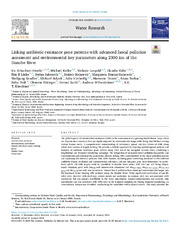Приказ основних података о документу
Linking antibiotic resistance gene patterns with advanced faecal pollution assessment and environmental key parameters along 2300 km of the Danube River
| dc.creator | Schachner-Gröhs, Iris | |
| dc.creator | Koller, Michael | |
| dc.creator | Leopold, Melanie | |
| dc.creator | Kolm, Claudia | |
| dc.creator | Linke, Rita | |
| dc.creator | Jakwerth, Stefan | |
| dc.creator | Kolarević, Stoimir | |
| dc.creator | Kračun-Kolarević, Margareta | |
| dc.creator | Kandler, Wolfgang | |
| dc.creator | Sulyok, Michael | |
| dc.creator | Vierheilig, Julia | |
| dc.creator | Toumi, Marwene | |
| dc.creator | Farkas, Rózsa | |
| dc.creator | Toth, Erika | |
| dc.creator | Kittinger, Clemens | |
| dc.creator | Zarfel, Gernot | |
| dc.creator | Farnleitner, Andreas | |
| dc.creator | Kirschner, Alexander | |
| dc.date.accessioned | 2024-03-11T09:52:50Z | |
| dc.date.available | 2024-03-11T09:52:50Z | |
| dc.date.issued | 2024 | |
| dc.identifier.issn | 0043-1354 | |
| dc.identifier.uri | http://radar.ibiss.bg.ac.rs/handle/123456789/6581 | |
| dc.description.abstract | The global spread of antimicrobial resistance (AMR) in the environment is a growing health threat. Large rivers are of particular concern as they are highly impacted by wastewater discharge while being vital lifelines serving various human needs. A comprehensive understanding of occurrence, spread and key drivers of AMR along whole river courses is largely lacking. We provide a holistic approach by studying spatiotemporal patterns and hotspots of antibiotic resistance genes (ARGs) along 2311 km of the navigable Danube River, combining a longitudinal and temporal monitoring campaign. The integration of advanced faecal pollution diagnostics and environmental and chemical key parameters allowed linking ARG concentrations to the major pollution sources and explaining the observed patterns. Nine AMR markers, including genes conferring resistance to five different antibiotic classes of clinical and environmental relevance, and one integrase gene were determined by probe-based qPCR. All AMR targets could be quantified in Danube River water, with intI1 and sul1 being ubiquitously abundant, qnrS, tetM, blaTEM with intermediate abundance and blaOXA-48like, blaCTX−M-1 group, blaCTX−M-9 group and blaKPC genes with rare occurrence. Human faecal pollution from municipal wastewater discharges was the dominant factor shaping ARG patterns along the Danube River. Other significant correlations of specific ARGs were observed with discharge, certain metals and pesticides. In contrast, intI1 was not associated with wastewater but was already established in the water microbiome. Animal contamination was detected only sporadically and was correlated with ARGs only in the temporal sampling set. During temporal monitoring, an extraordinary hotspot was identified emphasizing the variability within natural waters. This study provides the first comprehensive baseline concentrations of ARGs in the Danube River and lays the foundation for monitoring future trends and evaluating potential reduction measures. The applided holistic approach proved to be a valuable methodological contribution towards a better understanding of the environmental occurrence of AMR. | sr |
| dc.language.iso | en | sr |
| dc.publisher | Elsevier | sr |
| dc.relation | Austrian Science Fund (FWF, project P32464) | sr |
| dc.relation | International Commission for the Protection of the Danube River JDS4 | sr |
| dc.rights | openAccess | sr |
| dc.rights.uri | https://creativecommons.org/licenses/by/4.0/ | |
| dc.source | Water Research | sr |
| dc.subject | Antimicrobial resistance | sr |
| dc.subject | Environmental surveillance | sr |
| dc.subject | Genetic microbial source tracking | sr |
| dc.subject | QPCR | sr |
| dc.subject | Surface water | sr |
| dc.subject | Wastewater | sr |
| dc.title | Linking antibiotic resistance gene patterns with advanced faecal pollution assessment and environmental key parameters along 2300 km of the Danube River | sr |
| dc.type | article | sr |
| dc.rights.license | BY | sr |
| dc.rights.holder | © 2024 The Authors. Published by Elsevier Ltd. | sr |
| dc.citation.volume | 252 | |
| dc.identifier.doi | 10.1016/j.watres.2024.121244 | |
| dc.identifier.pmid | 38340455 | |
| dc.identifier.scopus | 2-s2.0-85184759779 | |
| dc.citation.spage | 121244 | |
| dc.type.version | publishedVersion | sr |
| dc.identifier.fulltext | https://radar.ibiss.bg.ac.rs/bitstream/id/17050/1-s2.0-S0043135424001441-main.pdf | |
| dc.citation.rank | aM21~ |

